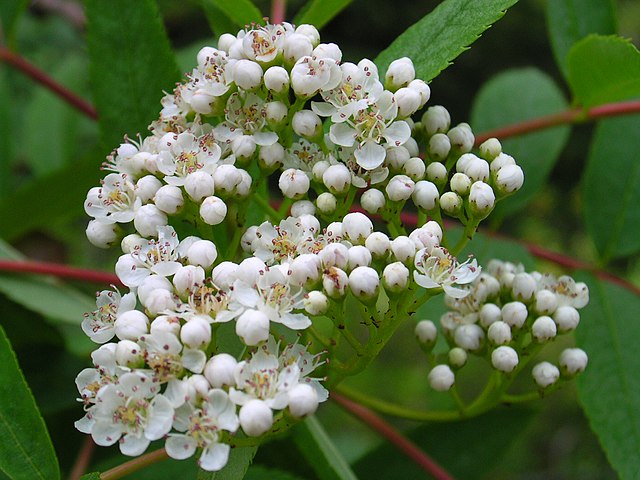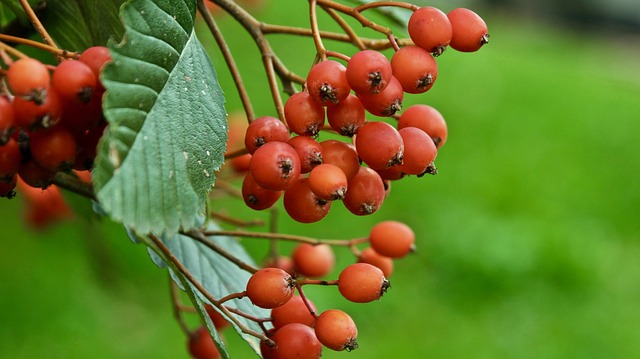

This guide is meant to teach you how to propagate Mountain Ash (Sorbus Americana) and hopefully make it easier for you to sell them at your own nursery.

Hardiness Zone: 2 – 6

Soil Type: Well-drained acidic, loamy, moist, sandy, and clay soils

Water: Normal. Drought Resistance

Exposure: Full Sun to Partial Shade
Mountain Ash (Sorbus Americana) is a deciduous tree hardy up to hardiness zone 2. There are a few characteristics that can help you identify montain ash.
How to Identify Mountain Ash
Bark

When young, mountain ash bark is smooth and grayish brown with numerous lenticels. It develops cracks, splits, and gets scaly patches with age.
When you look closely, you’ll commonly see small horizontal lines on its bark. Those lines are the lenticels, which is what allows for gas exchange of CO2 and oxygen during bark photosynthesis.
Leaves

Mountain ash leaves are alternate, pinnately compound, lance-shaped, and grow from 6 to 10 inches long. The leaf edges are serrated, and their color is dark green above, paler below.
Flowers

Mountain ash blooms into showy clusters of small white flowers. They are usually 3 to 5 inches across and appear in late spring to early summer.
Fruits

The fruits form in clusters of red, small (1/4 to 3/8 inch in diameter) pomes. They are showy, ripen in fall, and persist through the winter.
Are Mountain Ash Fruits Edible?
Mountain ash berries(rowan berries) are edible but don’t really taste good on their own. They have a highly astringent taste, but they can still be used if cooked or transformed properly.
The key is to pick mountain ash berries after frost.
You can make a nice rowan berry drink with orange and grapefruit peel. You can also turn the berries into jelly, syrup, and jam. Forager Chef mentions how to cook with rowan berries.
Habitat
Mountain ash prefers moist habitats like swamp borders and rocky hillsides.
They are common in openings or in woods, scattered on uplands along edges of woods, roadsides, and under semi-open stands.
They grow in a stunted form on dryer soils, prefers sun to shade.
If you look at their habitat range on the USDA Plants Map, they are native to the area around the great lakes, southeastern Canada, and Appalachia in the United States.
Lifespan: Wild Grown Vs. Home Grown
Wild Grown: Wild Mountain ash on average has a lifespan of 50-70 years under optimal conditions.
Home Grown: When you grow Mountain ash on home landscapes, you could expect a shorter lifespan. Generally, they can only be expected to live from 25-50 years.
Commercial value
Mountain ash lumber has limited value because the wood is rarely large enough to be worthwhile.
They have great commercial value as landscape trees.
It’s a beautiful ornamental tree for front yards and it attracts all sorts of wildlife.
Wildlife Value
Mountain ash is a beneficial tree for a variety of mammals, birds, and insects.
For example, catbirds, thrushes, and waxwings like to feed on their fruits.
Some species of insects like butterflies and bees love to collect nectar from their flowers.
Occasionally, big mammals such as moose also come to browse on the trees.
Best Way to Propagate Mountain Ash
How to Propagate by Seed
One sure way to propagate mountain ash is by planting its seeds.
First, there are a few things to do before, if you can’t buy seeds online, you can harvest some yourself.
They’ll also need to go through stratification.
How to Harvest Mountain Ash Seeds
You can get them from the fruits in August or early September.
Inside each fruit, you can harvest 4 seeds. The best way to do this is the crush them, filter the juice, and flesh them out with a sieve.
Here’s what they look like:


Alternatively, you can order sorbus americana seeds online here at Mount Royal Seeds.
Mountain Ash Seed Germination
If you want to reproduce the natural process for your seeds, you’ll need to put them through stratification. Here’s how to do it:
- Put the seeds in a plastic bag with moistened sand or peat moss and place them into an isolated part of your refrigerator (Temp must be around 2C).
- Allow them to cold-moist stratify for a minimum of 60 days, up to 180 days.
- Next, place them in room temp water for a few days to scarify.
- Then, plant your seeds in a 3″ deep planter under very light soil cover (1/2 to 1″ deep). Keep an even moisture throughout growth cycle (don’t allow to completely dry).
- Finally when they’re ready to transplant, 6-12 inch deep pots filled with 50/50 peat moss/sand is perfect.
Alternatively, you can just place them in pots with compost/sand outside during the winter. It’s important to make sure they don’t dry out and that they’re safe from vermin.
That way they’ll germinate the following spring.
How to Propagate Mountain Ash with Cuttings
The easiest way to propagate mountain ash with cuttings is with semi-hardwood. That’s new year growth that’s gone partly hard.
Very important: Take your cuttings only from young, healthy plants. Older trees lose their ability to regenerate over the years.

- First, identify a branch that’s got new growth on it. Inspect closely to see the difference between old growth and new growth.
- Find a piece of branch that’s not firm, brown old growth, it’ll be green but by now it will have gone semi hard.
- Snip a cutting just below a node, make sure the width of the cutting is not too thin, 1/4 inch width is fine, and they should be 6-8 inches long. Remove leaves except for 1-2 at the top, if they are too big cut the leaves in half.
- Wound the base of the cuttings with a vertial line on opposite sides, about 1 inch long.
- Dip in rooting hormones and then plant into your sandy propagation beds.
- Keep watering the rooting medium, sand shouldn’t be too wet but it should stay moist.
- With proper warmth and moisture, roots should form within 4-6 weeks.
Recommended rooting medium: Peat moss or sand with perlite mix.
That’s it, that should have you covered to multiply your trees!
Let’s go propagate mountain ash!

Got any questions or tricks to add? Don’t be shy to comment below and spark up a conversation!


Found the info very helpful
Hi Guy, thanks for sharing your thoughts! May the plant propagation gods bless your mountain ashes!
After cleaning and separating the seeds from pulp , do you let them dry or just just bag and freeze them wet ? Thanks
Hi Don, I prefer to let my seeds dry before storage because I don’t always stratify them right away. Although I don’t see a problem if you just bag and freeze them like that right away. Cheers